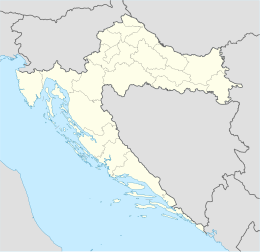Svetac
Native name: Štondrija Nickname: Svetac | |
|---|---|
 | |
 | |
| Geography | |
| Location | Adriatic Sea |
| Coordinates | 43°01′33″N 15°44′56″E / 43.0257402900°N 15.7489017300°E |
| Archipelago | Vis Islands |
| Area | 4.19 km2 (1.62 sq mi) |
| Highest elevation | 316 m (1037 ft) |
| Highest point | Kosa |
| Administration | |
| County | Split-Dalmatia |
Sveti Andrija (Croatian pronunciation: [svȇtī ǎndrija], meaning "Saint Andrew"), often called Svetac (Croatian pronunciation: [sʋěːtat͡s], meaning "saint"), is an island in the Croatian part of the Adriatic Sea. It is situated 14 nautical miles (26 km) from Komiža (a town on the island of Vis). It is uninhabited, although it used to have permanent residents.
Svetac was inhabited in prehistoric era, as evidenced by archeological remains, the oldest of which were found in Tovorski bod, a cave in the south part of the island.[1] A Benedictine monastery built on the island was abandoned in late 15th or early 16th century.[2] In 1760, a small pine tar factory was opened.[3] After the pine forest on the island was completely cut down, the factory was closed, and Svetac was acquired by members of Zanki family, who settled there.[3] The population census on Svetac from 1951 was around 60, all members of Zanki family. The last one of the group who lived there all year round was Antonija Zanki, an elderly woman who died in 2001.[1] Now members of Zanki family effectively live there four to six months a year, from late spring to autumn,[1] still keeping up the houses of their grandfathers, fishing, making red wine and olive oil. Most of members of Zanki family who own this, biggest private island in Adriatic, live in Komiža now (14 nm east). Svetac island is in open seas, without any natural protected bay, and members of the Zanki family survived there for centuries.[4]
Approximately 300 meters off the south-west coast of the island there is the islet of Kamik, and farther on the open sea there is the volcanic island called Jabuka.[5] About 2.5 kilometres (1.3 nautical miles)[6] to the southeast there is the small volcanic island of Brusnik.
Svetac is a breeding ground for a small number of Eleonora's falcons, a rare bird with only c. 40–80 nesting pairs estimated to live on the outer Croatian Adriatic islands.[7][8] The falcons migrate to Madagascar every September and return to their nests in April.[1]
See also
References
- ^ a b c d Šerić 2006, p. 18.
- ^ Šerić 2006, p. 19.
- ^ a b Šerić 2006, p. 23.
- ^ A tip about the island on dalmatia.hr Archived 2007-05-27 at the Wayback Machine
- ^ Šerić 2006, p. 22.
- ^ Duplančić Leder, Tea; Ujević, Tin; Čala, Mendi (June 2004). "Coastline lengths and areas of islands in the Croatian part of the Adriatic Sea determined from the topographic maps at the scale of 1 : 25 000" (PDF). Geoadria. 9 (1). Zadar: 5–32. doi:10.15291/geoadria.127. Retrieved 2019-12-06.
- ^ "Ugroženog Eleonorina sokola na Svecu prati nadzorna kamera". Slobodna Dalmacija (in Croatian). 24 July 2012. Retrieved 25 July 2012.
- ^ "The status and distribution of Eleonora's falcon (Falco eleonorae Gene 1834) in Croatia" (PDF). Natura Croatica. 6 (3). Croatian Natural History Museum: 323–333. 1997. Retrieved 16 July 2020.
Bibliography
- Šerić, Neven (2006). Biserna ogrlica - pučinski otoci srednjeg Jadrana (RTF) (in Croatian). Marjan tisak. ISBN 953-214-367-X. Retrieved 5 July 2018.
- Mithad Kozličić, Josip Faričić: "The Significance of Sv. Andrija Island (Svetac) on a Sailing Route Across the Adriatic Presented on Old Geographical Maps"

